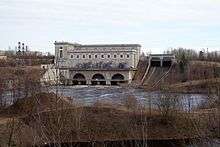Ivangorod
Ivangorod (Russian: Иванго́род, IPA: [ɪvɐnˈɡorət]; Estonian: Jaanilinn; Votic: Jaanilidna) is a town in Kingiseppsky District of Leningrad Oblast, Russia, located on the right bank of the Narva River by the Estonia–Russia border, 159 kilometers (99 mi) west of St. Petersburg. Population: 9,854 (2010 Census);[4] 11,206 (2002 Census);[10] 11,833 (1989 Census).[11]
Ivangorod Ивангород | |
|---|---|
Town[1] | |
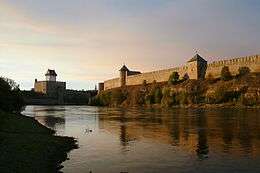 The reconstructed fortress of Narva (to the left) overlooking the Russian fortress of Ivangorod (to the right) | |
.png) Coat of arms | |
Location of Ivangorod 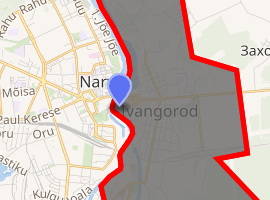
| |
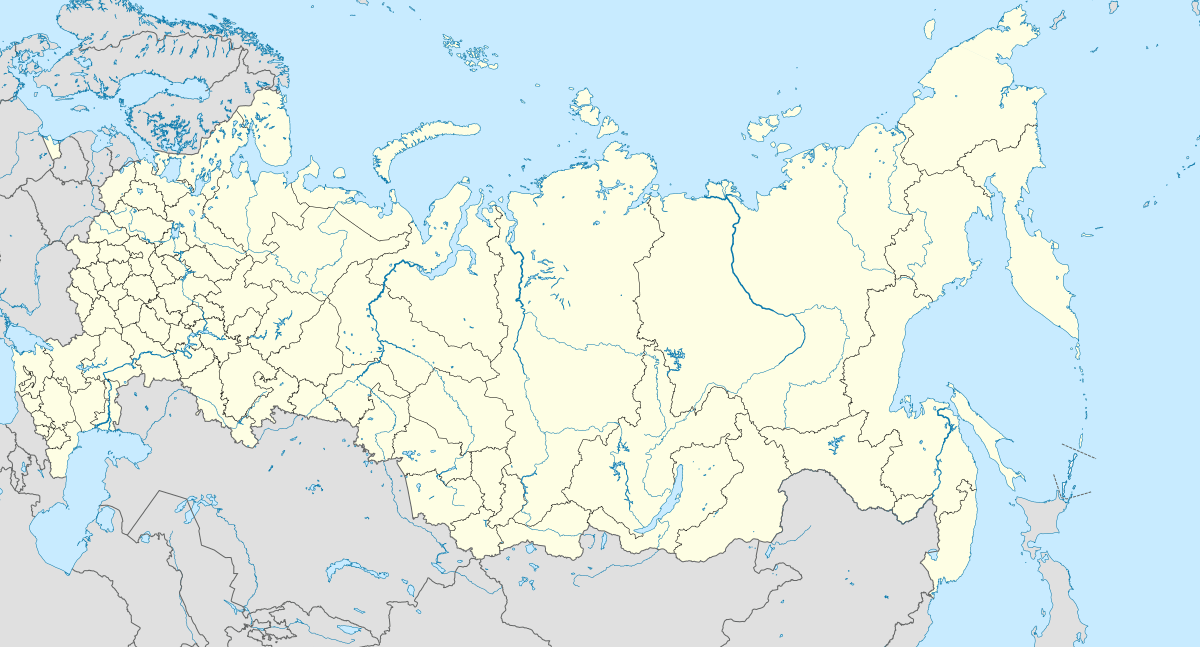 Ivangorod Location of Ivangorod 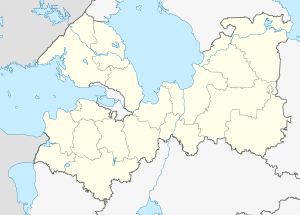 Ivangorod Ivangorod (Leningrad Oblast) | |
| Coordinates: 59°22′N 28°13′E | |
| Country | Russia |
| Federal subject | Leningrad Oblast[1] |
| Administrative district | Kingiseppsky District[1] |
| Settlement municipal formation | Ivangorodskoye Settlement Municipal Formation[1] |
| Founded | 1492[2] |
| Town status since | October 28, 1954[3] |
| Elevation | 32 m (105 ft) |
| Population | |
| • Total | 9,854 |
| • Estimate (2018)[5] | 10,453 (+6.1%) |
| • Capital of | Ivangorodskoye Settlement Municipal Formation[1] |
| • Municipal district | Kingiseppsky Municipal District[6] |
| • Urban settlement | Ivangorodskoye Urban Settlement[6] |
| • Capital of | Ivangorodskoye Urban Settlement[6] |
| Time zone | UTC+3 (MSK |
| Postal code(s)[8] | 188490, 188491 |
| Dialing code(s) | +7 81375[9] |
| OKTMO ID | 41621102001 |
| Website | www |
Ivangorod is a major border crossing point and a railway station by the Tallinn–St. Petersburg line. It is located just opposite to the Estonian town of Narva.
The town is the site of the Ivangorod Fortress, a prominent fortification monument of the 15th and the 16th centuries.
History
![]()
![]()
![]()
![]()
![]()
![]()
![]()
![]()
![]()
![]()
![]()
![]()
The fortress, established in 1492 during the reign of Ivan III of Moscow,[2] took its name (literally: Ivan-town — gorod in Russian means "town" or "city") from that of the Tsar. Between 1581 and 1590 and from 1612 to 1704, Sweden controlled the area.[2] Ivangorod was granted town privileges and administered as a Russian township under the Crown of Sweden (who conquered it in 1612 from boyar Teuvo Aminev) until 1649, when its burghers were ordered to remove to a Narva suburb. In 1617 Russia and Sweden signed the Treaty of Stolbovo, which placed the area under Swedish sovereignty. Russia reconquered it during the Great Northern War in 1704.[12] Despite other changes in territory and sovereignty, Ivangorod was considered an administrative part of the town of Narva from 1649 until 1945. In 1780, Ivangorod, together with Narva, was included into Narvsky Uyezd of St. Petersburg Governorate. In 1796, Narvsky Uyezd was abolished and merged into Yamburgsky Uyezd.

During the Estonian War of Independence (1918-1920), the newly independent Republic of Estonia established control over the whole of Narva, including Ivangorod, in January 1919, a move which Soviet Russia recognized in the 1920 Treaty of Tartu. In January 1945 Soviet authorities defined the Narva River as the border between the Estonian SSR and Russian SFSR, and as a result the administration of Ivangorod transferred from Narva to the Kingiseppsky District of Leningrad Oblast. Having grown in population, Ivangorod gained town status on October 28, 1954.[3]
After the restoration of Estonian independence in 1991, there have been some disputes about the Estonian-Russian border in the Narva area, as the new constitution of Estonia (adopted in 1992) recognizes the 1920 Treaty of Tartu border to be currently legal. The Russian Federation, however, regards Estonia as a successor of the Estonian SSR and recognizes the 1945 border between two former national republics. Officially, Estonia has no territorial claims in the area,[13][14] which is also reflected in the new Estonian-Russian border treaty, according to which Ivangorod remains a part of Russia. Although the foreign ministers of Estonia and Russia signed the treaty in 2005, due to continuing political tensions it has not been ratified.
Administrative and municipal status
Within the framework of administrative divisions, it is, together with two rural localities, incorporated within Kingiseppsky District as Ivangorodskoye Settlement Municipal Formation.[1] As a municipal division, Ivangorodskoye Settlement Municipal Formation is incorporated within Kingiseppsky Municipal District as Ivangorodskoye Urban Settlement.[6]
Restricted access
The town of Ivangorod is included into the border security zone, intended to protect the borders of Russia from unwanted activity. In order to visit the zone, a permit issued by the local Federal Security Service department or a valid Schengen visa is required. An EU passport with a Russian visa is also valid (2016).[15]
Economy
Industry
Ivangorod has enterprises of textile, food, and timber industries, as well as a plant producing metallic plants and reservoirs. The Narva Hydroelectric Station is located in the town limits as well.[16]
Transportation
The railway connecting St. Petersburg with Tallinn passes through Ivangorod. There is infrequent suburban service to Baltiysky railway station of St. Petersburg, as well as passenger service to Tallinn.
The A180 Highway connects St. Petersburg and Ivangorod. It coincides with the European route E20 connecting St. Petersburg via Tallinn with Shannon Airport.
Culture

Ivangorod contains thirty-three cultural heritage monuments of federal significance and additionally seven objects classified as cultural and historical heritage of local significance. All federal monuments are related to the Ivangorod Fortress.[17] The fortress functions as a museum.[18]
Twin towns and sister cities
Ivangorod is twinned with:
References
Notes
- Oblast Law #32-oz
- Энциклопедия Города России. Moscow: Большая Российская Энциклопедия. 2003. p. 150. ISBN 5-7107-7399-9.
- "Archived copy" Кингисеппский район (август 1927 г.) (in Russian). Система классификаторов исполнительных органов государственной власти Санкт-Петербурга. Archived from the original on December 11, 2013. Retrieved February 28, 2014.CS1 maint: archived copy as title (link)
- Russian Federal State Statistics Service (2011). "Всероссийская перепись населения 2010 года. Том 1" [2010 All-Russian Population Census, vol. 1]. Всероссийская перепись населения 2010 года [2010 All-Russia Population Census] (in Russian). Federal State Statistics Service.
- "26. Численность постоянного населения Российской Федерации по муниципальным образованиям на 1 января 2018 года". Federal State Statistics Service. Retrieved January 23, 2019.
- Law #81-oz
- "Об исчислении времени". Официальный интернет-портал правовой информации (in Russian). June 3, 2011. Retrieved January 19, 2019.
- Почта России. Информационно-вычислительный центр ОАСУ РПО. (Russian Post). Поиск объектов почтовой связи (Postal Objects Search) (in Russian)
- Общая информация об Ивангороде (in Russian). Ivangorod official website. Retrieved February 28, 2014.
- Russian Federal State Statistics Service (May 21, 2004). "Численность населения России, субъектов Российской Федерации в составе федеральных округов, районов, городских поселений, сельских населённых пунктов – районных центров и сельских населённых пунктов с населением 3 тысячи и более человек" [Population of Russia, Its Federal Districts, Federal Subjects, Districts, Urban Localities, Rural Localities—Administrative Centers, and Rural Localities with Population of Over 3,000] (XLS). Всероссийская перепись населения 2002 года [All-Russia Population Census of 2002] (in Russian).
- "Всесоюзная перепись населения 1989 г. Численность наличного населения союзных и автономных республик, автономных областей и округов, краёв, областей, районов, городских поселений и сёл-райцентров" [All Union Population Census of 1989: Present Population of Union and Autonomous Republics, Autonomous Oblasts and Okrugs, Krais, Oblasts, Districts, Urban Settlements, and Villages Serving as District Administrative Centers]. Всесоюзная перепись населения 1989 года [All-Union Population Census of 1989] (in Russian). Институт демографии Национального исследовательского университета: Высшая школа экономики [Institute of Demography at the National Research University: Higher School of Economics]. 1989 – via Demoscope Weekly.
- История Ивангорода (in Russian). Ivangorod official website. Archived from the original on August 12, 2013. Retrieved April 8, 2013.
- Berg, Eiki. "Milleks meile idapiir ja ilma lepinguta?". Eesti Päevaleht (in Estonian). Archived from the original on October 9, 2007. Retrieved September 27, 2009.
- "Enn Eesmaa: väide Petseri-soovist on ennekõike provokatiivne". Eesti Päevaleht. Archived from the original on August 26, 2009. Retrieved September 27, 2009.
- Приказ ФСБ РФ от 2 июня 2006 года №239 "О пределах пограничной зоны на территории Ленинградской области"; Приказ ФСБ РФ от 5 мая 2007 г. №222 "О внесении изменений в Приказ ФСБ РФ ОТ 2 июня 2006 г. №239 "О пределах пограничной зоны на территории Ленинградской области"". Rossiyskaya Gazeta (in Russian). 2006.
- Коммерческие организации города (in Russian). Ivangorod official website. Retrieved April 7, 2013.
- Памятники истории и культуры народов Российской Федерации (in Russian). Russian Ministry of Culture. Retrieved June 2, 2016.
- Историко-архитектурный и художественный музей "Ивангородская крепость" (in Russian). Российская сеть культурного наследия. Retrieved March 26, 2013.
Sources
- Законодательное собрание Ленинградской области. Областной закон №32-оз от 15 июня 2010 г. «Об административно-территориальном устройстве Ленинградской области и порядке его изменения», в ред. Областного закона №23-оз от 8 мая 2014 г. «Об объединении муниципальных образований "Приморское городское поселение" Выборгского района Ленинградской области и "Глебычевское сельское поселение" Выборгского района Ленинградской области и о внесении изменений в отдельные Областные законы». Вступил в силу со дня официального опубликования. Опубликован: "Вести", №112, 23 июня 2010 г. (Legislative Assembly of Leningrad Oblast. Oblast Law #32-oz of June 15, 2010 On the Administrative-Territorial Structure of Leningrad Oblast and on the Procedures for Its Change, as amended by the Oblast Law #23-oz of May 8, 2014 On Merging the Municipal Formations of "Primorskoye Urban Settlement" in Vyborgsky District of Leningrad Oblast and "Glebychevskoye Rural Settlement" in Vyborgsky District of Leningrad Oblast and on Amending Various Oblast Laws. Effective as of the day of the official publication.).
- Законодательное собрание Ленинградской области. Областной закон №81-оз от 28 октября 2004 г. «Об установлении границ и наделении соответствующим статусом муниципального образования Кингисеппский муниципальный район и муниципальных образований в его составе», в ред. Областного закона №17-оз от 6 мая 2010 г «О внесении изменений в некоторые областные законы в связи с принятием федерального закона "О внесении изменений в отдельные законодательные акты Российской Федерации в связи с совершенствованием организации местного самоуправления"». Вступил в силу через 10 дней со дня официального опубликования (29 ноября 2004 г.). Опубликован: "Вестник Правительства Ленинградской области", №34, 19 ноября 2004 г. (Legislative Assembly of Leningrad Oblast. Oblast Law #81-oz of October 28, 2004 On Establishing the Borders of and Granting an Appropriate Status to the Municipal Formation of Kingiseppsky Municipal District and to the Municipal Formations Comprised By It, as amended by the Oblast Law #17-oz of May 6, 2010 On Amending Various Oblast Laws Due to the Adoption of the Federal Law "On Amending Various Legislative Acts of the Russian Federation Due to the Improvement of the Organization of the Local Self-Government". Effective as of after 10 days from the day of the official publication (November 29, 2004).).
External links
- Official website of Ivangorod (in Russian)
- Photo gallery
